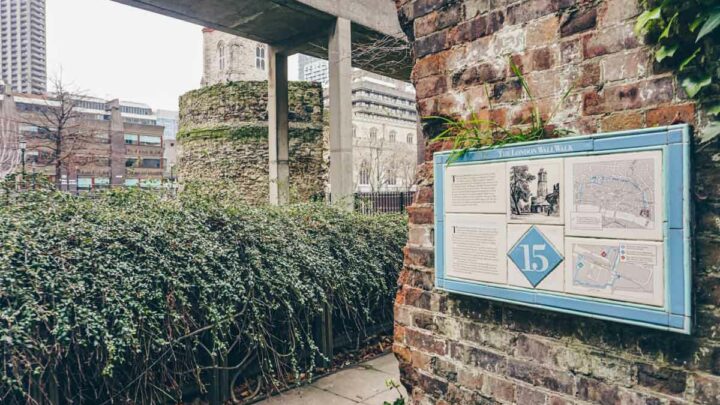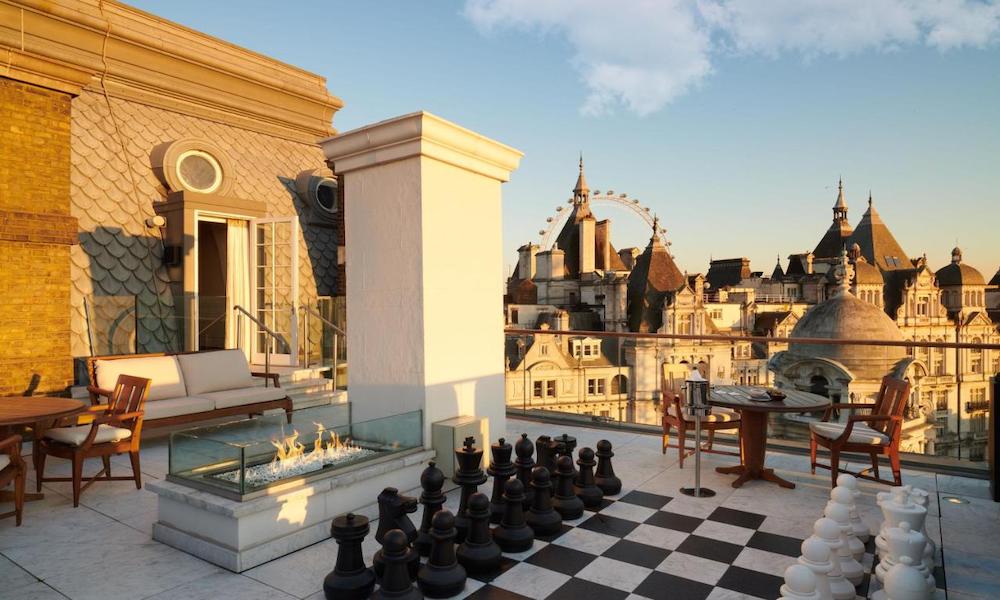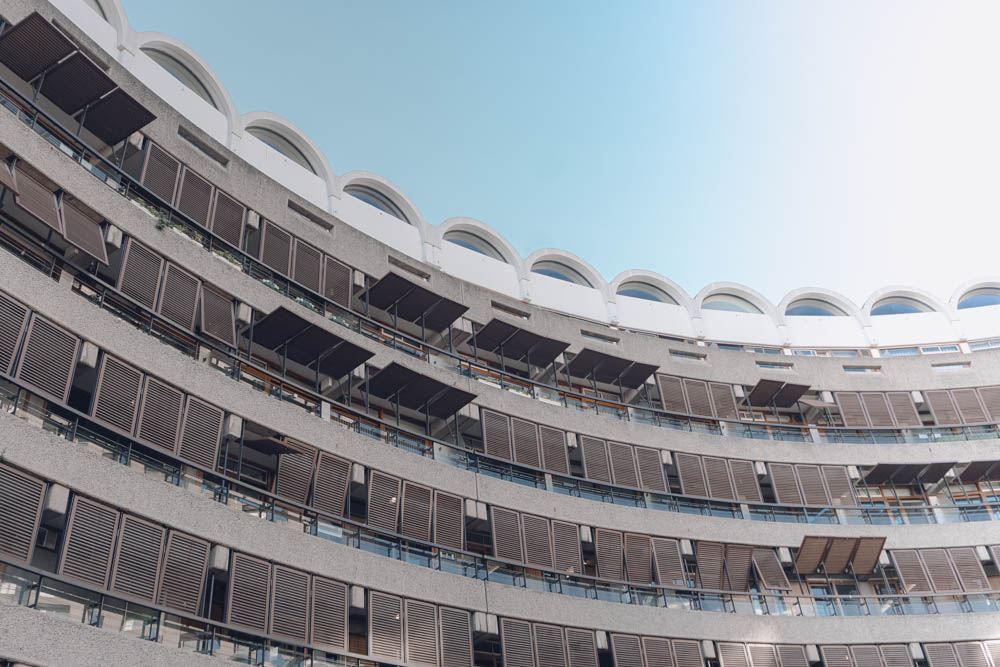
Discover London’s ancient side with this self-guided walk of the city’s Roman Walls.
We bet you’ve heard of Hadrian’s Wall. And you’ve definitely heard of the Great Wall of China. But, have you ever heard of the London wall? It’s something of a little secret, but London has its own wall that rivals its more famous counterparts (well, kind of).
Believed to have been built by Roman Emperor Severus, the remaining part of the London Wall spans across the City of London and the south of Finsbury – and there’s a brilliant walk that takes you to the historical gates, towers, and portions of the wall that are still standing today. More on that anon.
Are you ready to discover ancient London?
If you’re looking to visit the old London Wall, don’t miss our guide to the interesting history and all the reasons you should visit.
We’ve even included a handy walkthrough and London Wall map to get you started – don’t say we don’t treat you!
Why Visit the London Wall?
There are plenty of reasons that you should visit the London city Wall, whether you just want to stop by a particular gate or are prepared to undertake the whole walk.
But if you’re not convinced, let us give you the low down. Don your comfiest walking shoes and pack a bottle of water, because these are the reasons why you should visit the London Wall…
It’s Oozing With History
If you’re looking for a day out with an educational twist, this is for you.
You’ll pass the Tower of London, historic churches and gardens, along with impressive sections of the wall – all narrated by plaques that give you some background information on the wall and Roman London.
The 7 Gates of London
You’ll also get to know the 7 gates of London, originally used to allow access out of the walled boundary and into the rest of England – although, they were destroyed in 1761 when the roads were widened into the capital.
The gates were called Aldgate, Bishopsgate, Moorgate, Cripplegate, Aldersgate, Newgate, and Ludgate, and you’ll get to see the remains of most of them as you wander through the city.
You Get to see More of the City
London is filled with attractions that are often overcrowded and underwhelming, but taking on the wall will give you the opportunity to escape the busy tourist traps in a unique way.
Did we mention that the London city wall walk is totally free? The capital has plenty of quirky free things to do, so no matter your budget you can still find something fun to do in the city.
The Whole Family Can Get Involved
Firstly, the walk isnt too long, so even little legs will be able to manage it. But, you’ll also pass through plenty of cute streets filled with cafes and restaurants so you can take a pit stop if needed.
There’s Lots to do in the City of London
I highly recommend taking a mini detour to the Sky Garden while you’re in the area. With panoramic views of the London skyline, a reasonably-priced cafe, and pretty leafy interior (also it’s free, but tickets need to be booked in advance), it’s the perfect spot to relax before continuing on with the wall walk.
While you’re near, why not pop into Leadenhall Market, a stunning covered market that transports you back in time – it actually began as a Roman bazaar, so it’s quite fitting with the day’s theme.
A Brief History of the London Wall
Known as the city of Londinium during Roman rule, London has long been supported by fortification – the original stone wall is thought to have been constructed between AD 190 and 225, providing protection and a flashy reminder of the city’s status.
It’s thought that the wall spanned 2.5 miles, surrounding an area of 330 acres with four city gates and an entrance to a grand fortress at Cripplegate.
When the Roman army left London in AD 410, the wall remained standing even though the city was basically abandoned. The anglo-saxons later repaired the wall, which became a vital feature of the city during the Norman Conquest in 1066 – the wall was the main defence mechanism of the city, preventing other soldiers from invading.
In the 17th century, buildings were constructed on either side of the wall, which was eventually rendered totally useless and partly destroyed.
But more recently, the western part of the wall and surrounding land were put under protection by the Ministry of Works. And since then, parts of the old London Wall have been revealed through the demolition of nearby buildings.
London Wall Walk
Fancy taking on the London Wall walk? Of course you do.
The walk stretches from the Tower of London to the Museum of London and takes around an hour to complete (although, we’d leave an afternoon free so you can really explore). The easiest way to complete the walk is by following the numbered plaques, which tell you more about the history as you go.
Does it matter which end you start? Not really, but to make things simple we recommend starting at the Tower of London. There you’ll find an interesting introductory plaque to help you get your bearings and give you the low-down before you begin.
Don’t worry if it seems daunting, we’ve put together a handy walkthrough to help you get the most out of your walk, along with a London Wall map.
Postern Gate
The first plaque can be found around the corner from the Tower of London. It’s not too difficult to find, just head the the subway between the Tower of London and Tower Hill Tube Station and you’ll find Postern Gate.
City Wall at Tower Hill
Head through the subway at Tower Hill towards the station and head up the first set of stairs – if you can see a garden area to the right, you’re on the right track. You’ll be able to see a large section of the wall here, and the plaque is located to the left.
You’ll also find a statue of Trajan, which was built by the Romans and erected in front of the Roman Wall London boasted to highlight their fearless leader (although, he never actually visited Britain).
City Wall at Coopers Row
Next, you’ll need to exit the station and head towards Trinity Square. Walk until you can see the Citizen M hotel, and make your way inside the entryway and through until you see more wall. Go under the archway and you’ll be greeted by plaque 3! Easy so far, right?
Oops, the next plaque doesn’t actually exist anymore, but it used to stand on Vine Street at the Emperor’s House. You’ll need to go this way anyway to find Plaque 5.
City Wall at Vine Street Museum
The most recent piece of city wall to go on display offers a chance to see a few other artefacts from Roman London. That’s because the wall is found in a museum.
City Wall at Vine Street is free to get in so you’ve got no excuses to miss it. It’s also the home to some great bits of information that’ll fill in the blanks on your Roman history and some other artefacts that have been dug up from the Roman level of the city.
These include some really fantastic glassware and ceramics.
Aldgate
From Vine Street, you’ll need to make your way onto India Street and then Jewry Street. After, head straight up to the front of Aldgate School, where the next plaque will be waiting.
Top tip: Sometimes this plaque can be hard to see as it’s behind a bicycle rack, so make sure you take a peek behind them if you can’t seem to find it!
City Wall at Bevis Marks
To find the next plaque, head to Bevis Marks Synagogue and the plaque is on the wall. You can’t see any of the London Wall here, but it’s a cool area to wander through nonetheless.
Like with plaque 4, the next few plaques are no longer standing, but you can still continue the walk to see more of the wall.
Head towards Bishopsgate and make your way over to the stunning Hallows-on-the-Wall church’s courtyard – there’s no plaque here, but the mediaeval portion of the wall is really cool.
Moorgate
Next, continue along to Moorgate and you’ll find a plaque in the northeast street corner, where Moorgate Street intersects with the London city Wall.
As the name suggests, this gate was used to give access to the moor and marsh that lay to the north of London during the middle ages, with the gate standing at this portion of the wall until it was destroyed in 1761.
City Wall at St Alphage
Are you still with us? We’re about halfway there now.
Continue along the north side of the wall towards St Alphage Gardens’ courtyard and you’ll find a charming park with benches so you can sit and really appreciate the structure. This is probably our favourite part of the wall – it’s just so pretty!
Cripplegate
Make your way to the nearby Wood Street, and keep your eyes peeled for a plaque on a building to your right.
Cripplegate was actually one of the main city gates on the wall, used to aid traffic in the city centre, though sadly it was destroyed (like the others) in 1761.
City Wall & Towers
Cross Wood Street and head over into the Barbican Estate, where you’ll find a railing with the next plaque and a crumbling portion of the wall alongside a section of St Giles’ Cripplegate tower.
This part of the wall was originally the northern segment of the Roman fort and marks a pond where medieval residents would fish – most of the stonework actually dates back to AC 120, when the walls defences were rebuilt.
St Giles at Cripplegate
Head back out of the estate, and make your way around to the nearby car park (you’ll be tempted to walk straight through the estate, but it’s actually private property). From here, you can access the back courtyard of the Barbican estate where you’ll find plaque 15.
Roman Fort West Gate
Walk to Barber-Surgeons Hall, where you’ll spot more sections of the mediaeval wall. And then enter the car park where you’ll find the next plaque, as well as remnants of the wall.
Plaques 18, 19 and 20 also no longer exist, but if you head to Noble Street, you’ll be able to find parts of the wall still standing.
Aldersgate
To reach the final plaque, you’ll need to pay close attention to these instructions.
Turn right onto Gresham Street at the intersection with St Anne’s Church, before taking another right onto St. Martin’s-le-Grand.
Walk up to the east side of the street until you reach plaque 21 (it should be next to another sign about the Aldersgate).
Then, continue left until you reach the rotunda roundabout, and you should be able to spot the old Museum of London straight ahead.
Museum of London
Hurrah! If you’ve made it to the old Museum of London, you’ve finished the London Wall walk. Give yourself a pat on the back, and take yourself for a well-deserved coffee.
We would have once recommended that you go inside and check out what the museum has: some fascinating artefacts and exhibitions that fill out the story of life in London through the ages. However, in 2023 the museum closed down and relocated.
It will reopen in 2026 in what used to be Smithfields Market. It’s not too far of a walk if you want to head over there once its up and running.
What Were the Romans Doing in London Anyway?
Well, pretty much founding it. There had been indigenous Brits living along the Thames for a long time before the Romans arrived but it was the invaders that built the city we know today.
They arrived in Britain in AD43 and by AD47 had established a town on the banks of the Thames. The site they chose would go on to become the Square Mile or The City of London, and would inadvertently be the oldest continuous democracy we have today.
The Romans probably didn’t know they were setting the foundations of a city that would rise to be one of the greatest the world has ever seen. They just liked the spot because it was the easiest location to bridge the Thames from.
London grew to become the centre of the Roman empire’s British frontier, and a grand city in its own right. Since then it’s been built upon by 2000 years of following civilisations. The walk you’ve just taken shows part of what remains of London’s Roman past.
The London Wall Walk: Practical Tips
- We’ve said it before, we’ll say it again. Make sure you’re wearing comfortable shoes for the walk. It’s not a massive hike but you don’t want to be trudging along in something that’s going to be hurting your feet after the first few stops.
- If it’s hot, take water and sun cream.
- You’ll have options for food and drinks along the route. The walk passes through some of the busiest parts of London so you’ll be spoilt for choice too. That said, we mentioned Sky Garden as a great spot to stop over and we stand by it. The views are incredible and the lunch options aren’t bad either.


